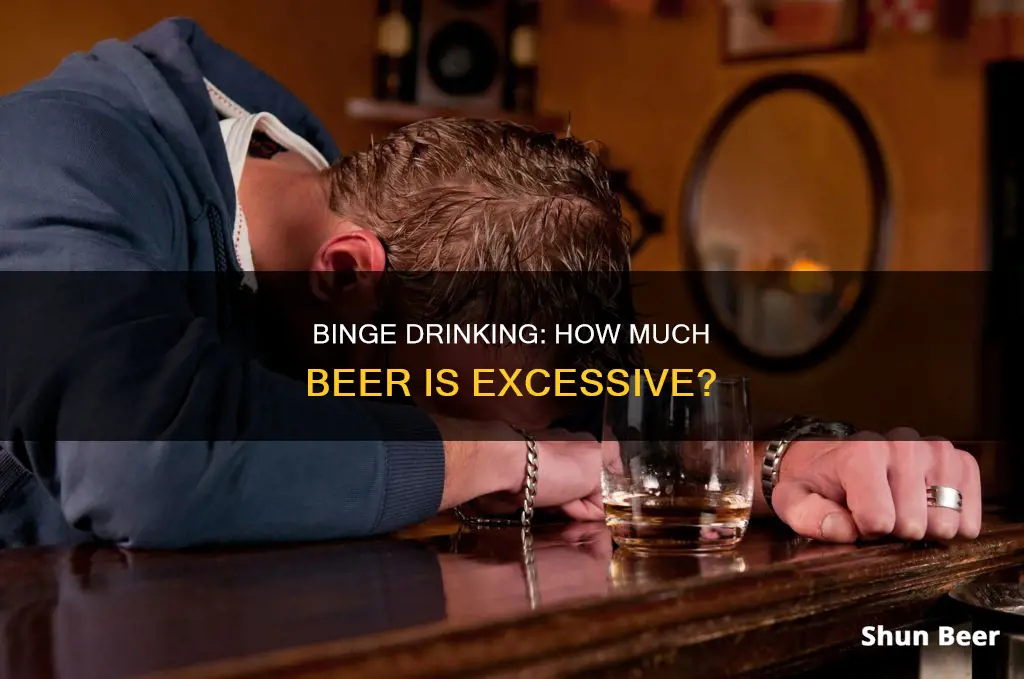
Binge drinking is a dangerous practice that involves consuming enough alcohol to significantly impair judgment, impulse control, and motor coordination. While there is no universal definition of binge drinking, it is generally understood as drinking heavily over a short period with the intention of becoming intoxicated. In the United States, binge drinking is typically defined as consuming four or more drinks for women and five or more drinks for men within a two-hour period. This drinking pattern can lead to a blood alcohol concentration (BAC) of 0.08% or higher, which is the legal limit for driving in many places. Binge drinking is associated with various health risks and negative consequences, including accidents, violence, and unsafe sexual behavior. It is a significant public health concern, particularly among adolescents and young adults, as it can lead to long-term cognitive impairments and increase the risk of developing an alcohol use disorder.
| Characteristics | Values |
|---|---|
| Definition of binge drinking | Drinking enough alcohol to bring blood alcohol concentration (BAC) to 0.08% or above |
| Number of drinks for men | 5 or more |
| Number of drinks for women | 4 or more |
| Time period | 2 hours |
| Definition by Stolle, Sack and Thomasius | Episodic excessive drinking |
| Definition by the National Institute on Alcohol Abuse and Alcoholism (NIAAA) | A pattern of drinking alcohol that brings blood alcohol concentration (BAC) to 0.08% or above |
| Definition by Substance Abuse and Mental Health Services Administration (SAMHSA) | 5 or more drinks for males or 4 or more drinks for females on the same occasion on at least 1 day in the past month |
| Definition by the US Centers for Disease Control and Prevention (2015) | A pattern of drinking that brings a person's blood alcohol concentration (BAC) to 0.08% or above |
What You'll Learn
- Binge drinking defined: drinking to reach a blood alcohol concentration (BAC) of 0.08% or higher
- Gender differences: men typically need five drinks, women four, to reach the binge drinking threshold
- Binge drinking health risks: short and long-term health issues, from hangovers to cancer
- Binge drinking and alcohol use disorder: the link between binge drinking and alcohol addiction
- Binge drinking prevention: tips to reduce the risk of binge drinking

Binge drinking defined: drinking to reach a blood alcohol concentration (BAC) of 0.08% or higher
Binge drinking is a pattern of drinking that brings a person's blood alcohol concentration (BAC) to 0.08% or above. This is equivalent to 0.08 g of alcohol per 100 ml of blood. In other words, a person's BAC is calculated as a percentage, measuring the mass of alcohol per volume of blood.
When a person's BAC reaches 0.08% or higher, they are considered legally impaired in the U.S. This is because a BAC of 0.08% or higher leads to significant impairments in judgment, impulse control, and motor coordination, increasing the likelihood of injuries and other harms.
The number of drinks it takes to reach a BAC of 0.08% can vary depending on a person's metabolism, size, and weight. On average, women typically reach this level after about four drinks, and men after about five drinks in two hours. However, it is important to note that these numbers are just averages and can vary from person to person.
To ensure safety and avoid the negative consequences of binge drinking, it is recommended to drink in moderation. This means limiting alcohol intake to no more than one drink per day for women and no more than two drinks per day for men.
Pregnant and Want a Beer? Here's What You Should Know
You may want to see also

Gender differences: men typically need five drinks, women four, to reach the binge drinking threshold
Binge drinking is a pattern of drinking that brings blood alcohol concentration (BAC) to 0.08% or above. This typically corresponds to consuming five or more drinks for men, or four or more drinks for women, in about two hours. However, it is important to note that this can vary based on individual factors such as metabolism, size, and weight.
When it comes to gender differences, men and women have different thresholds for what constitutes binge drinking. On average, men need to consume five drinks, while women need four drinks, to reach a BAC of 0.08% or higher. This difference is primarily due to variations in body weight and composition, as well as metabolic rates, between the two sexes.
The NIAAA defines binge drinking as a pattern of drinking that brings BAC to 0.08% or 0.08 grams of alcohol per deciliter or higher. This typically corresponds to five or more drinks for men and four or more drinks for women within a two-hour period. Similarly, the Substance Abuse and Mental Health Services Administration (SAMHSA) defines binge drinking as consuming five or more drinks for males or four or more drinks for females on the same occasion, such as during a party or within a couple of hours of each other, on at least one day in the past month.
Binge drinking is a serious public health concern, as it can lead to significant health problems and impairments in judgment, impulse control, and motor coordination. Additionally, it increases the likelihood of injuries and other harmful consequences. The effects of binge drinking are not limited to the individual but also extend to society as a whole, with economic costs and social consequences such as violence and unsafe sexual behavior.
While the gender difference in binge drinking thresholds is clear, it is important to note that binge drinking is not limited to any specific gender. Both men and women can engage in binge drinking, and the number of women who binge drink has been steadily increasing over the years. This increase may be due to the growing social acceptance of women drinking excessively. However, it is crucial to recognize that women are more susceptible to certain risks associated with excessive alcohol use, including liver disease, heart disease, blackouts, hangovers, and certain types of cancer.
Beer and Bodybuilding: Can You Enjoy an Occasional Pint?
You may want to see also

Binge drinking health risks: short and long-term health issues, from hangovers to cancer
Binge drinking is a common but dangerous activity. Defined as consuming enough alcohol to raise one's blood alcohol concentration to 0.08% or above, binge drinking can lead to a range of short- and long-term health issues.
Short-term health risks
Binge drinking can cause poor motor control, slower reaction times, and a shorter attention span. It can also lead to alcohol poisoning, which can be fatal. Other short-term effects include hangovers, vomiting, unintentional injuries, and STDs.
Long-term health risks
Over time, binge drinking can cause serious long-term damage to the body, including:
- Mental health problems
- Loss of brain volume in young people
- Weakened immune system
- High blood pressure, stroke, or other cardiovascular issues
- Higher chances of breast, throat, oesophagus, colon, liver, and mouth cancer
- Heart disease
- Dementia and declining mental function
- Alcoholic liver disease
- Osteoporosis
- Stroke
- Impaired balance and coordination
- Increased risk of depression, anxiety, and psychosis
- Reduced fertility in men and women
- Malnutrition
Binge drinking is typically defined as consuming four or more drinks for women and five or more drinks for men within a two-hour period. However, it's important to note that these numbers can vary based on factors such as metabolism, size, weight, age, sex, and ethnicity.
Mixing Beer and Cough Medicine: Is It Safe?
You may want to see also

Binge drinking and alcohol use disorder: the link between binge drinking and alcohol addiction
Binge drinking is a significant problem in the United States, with about 1 in 5 US adults between the ages of 20 and 49 dying from causes related to excessive drinking every year. Binge drinking is defined by the National Institute on Alcohol Abuse and Alcoholism (NIAAA) as a pattern of drinking that increases one's blood alcohol concentration (BAC) to roughly 0.08 grams per deciliter, which is typically achieved by consuming four or more drinks for women and five or more drinks for men within about two hours. This definition is echoed by the Substance Abuse and Mental Health Services Administration (SAMHSA). Binge drinking is associated with a range of negative consequences, including blackouts, unsafe sexual behavior, and an increased risk of sexually transmitted infections and unintentional pregnancy. It also increases the likelihood of potentially deadly consequences, including falls, burns, drownings, and car crashes.
Binge drinking is also linked to the development of alcohol use disorder (AUD). AUD is a medical condition characterized by an impaired ability to stop or control alcohol use despite adverse social, occupational, or health consequences. It includes conditions such as alcohol abuse, alcohol dependence, and alcoholism. Binge drinking increases the risk of developing AUD over time, and certain factors can further elevate this risk. For example, people who engage in heavy drinking during their teenage years are about three times more likely to develop AUD.
While not all binge drinkers are dependent on alcohol, binge drinking poses a serious threat to physical and mental health. It may serve as an early indicator of vulnerability to developing an alcohol use disorder. The line between binge drinking and addiction is fine, and both involve a compulsion to drink that is beyond the individual's control, leading to progressively negative consequences. If an individual finds themselves unable to limit their drinks or stop drinking when they intended to, they may have crossed the threshold from binge drinking to addiction.
The good news is that seeking help early can make the journey to recovery easier. Treatment options for binge drinking and alcohol use disorder are available, and they are customized for each individual. These treatment plans often include medical detox, partial hospitalization programs, intensive outpatient programs, traditional outpatient care, and aftercare or sober living support.
Pregnant Women and Alcohol: Is Cider Beer Safe?
You may want to see also

Binge drinking prevention: tips to reduce the risk of binge drinking
Binge drinking is a serious issue that can lead to substantial health and social problems. It is defined as drinking enough alcohol to raise one's blood alcohol concentration (BAC) to 0.08% or above, which typically corresponds to consuming 5 or more drinks for men, or 4 or more drinks for women, in about 2 hours. To prevent and reduce the risk of binge drinking, here are some essential tips:
Understand the Guidelines and Risks
Know the drinking guidelines provided by official sources, such as the National Institute on Alcohol Abuse and Alcoholism (NIAAA) and the U.S. Dietary Guidelines. These guidelines recommend moderation, suggesting that women should limit their intake to no more than one drink per day, while men should not exceed two drinks per day. Understanding the risks associated with binge drinking, such as impaired judgment, health issues, and social consequences, is crucial for making informed decisions.
Set Personal Limits and Goals
It is important to set personal limits and stick to them. Decide how many days a week you want to drink and how many drinks to have on those days. For example, you may choose to only drink on Friday nights and limit yourself to a specific number of drinks. This proactive planning can help prevent excessive drinking.
Practice Moderation Techniques
When drinking, there are several strategies to maintain moderation. Firstly, limit your intake by drinking slowly and alternating alcoholic drinks with non-alcoholic ones, preferably water. Secondly, ensure you have some food while drinking, as it can help slow down the absorption of alcohol. Lastly, drink in the company of trusted individuals who can support you in maintaining your limits and ensure your safety.
Avoid Triggers and High-Risk Situations
Triggers are people, places, or activities that may cause you to drink even when you don't want to. Identify and avoid these triggers to reduce the temptation to binge drink. This may include skipping happy hour events or refraining from drinking in places where alcohol is readily available. Additionally, be mindful of your surroundings and choose social activities that do not revolve heavily around alcohol.
Community Action and Support
Binge drinking is not just an individual issue but also a community concern. Support community initiatives that promote responsible drinking and reduce alcohol availability, especially to minors and intoxicated individuals. This can include responsible beverage service training for servers and bartenders, media campaigns that raise awareness about the dangers of binge drinking, and community sponsorship of alcohol-free activities.
Seek Help if Needed
If you feel that your drinking has become a problem or is causing issues in your life, don't hesitate to seek help. Talk to your doctor or reach out to federal and state health agencies, such as the NIAAA Alcohol Treatment Navigator, for guidance and support in cutting back or quitting drinking. Recognizing the issue and taking steps to address it is a crucial step towards improving your health and well-being.
Should Teenagers Drink Beer? Exploring the Risks and Regulations
You may want to see also
Frequently asked questions
Binge drinking is typically defined as consuming enough alcohol to reach a blood alcohol concentration (BAC) of 0.08% or higher. This usually corresponds to four or more drinks for women and five or more drinks for men within a two-hour period.
The number of drinks required to reach the binge drinking threshold can vary depending on individual factors such as metabolism, size, and weight. Smaller individuals may reach this threshold with fewer drinks.
Yes, binge drinking is associated with various short-term and long-term health risks, including impaired judgment, poor motor coordination, increased risk of injuries, alcohol poisoning, heart problems, mental health issues, and an increased likelihood of engaging in risky behaviours.







